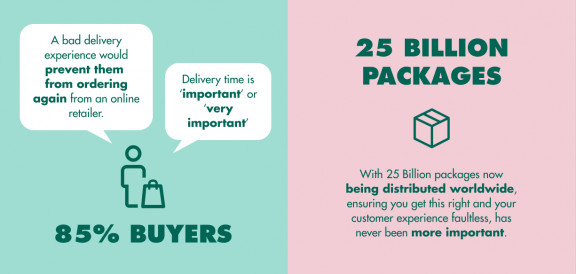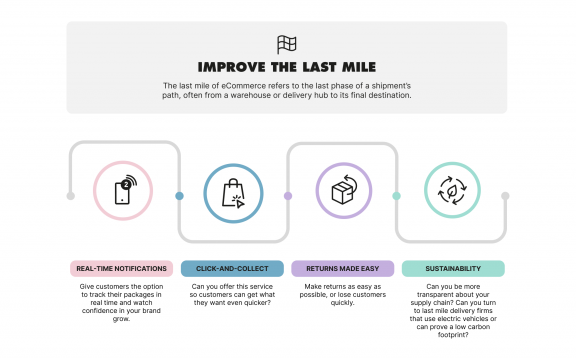
The last mile: how to improve the customer experience after checkout
The package was supposed to arrive yesterday. On the website, underneath the product description, it says ‘delivery, around two to three working days.’ It’s 2pm on day four and it still hasn’t turned up.
It’s your son’s eighth birthday tomorrow - he’s been desperate for the latest Barcelona football kit. You wouldn’t have ordered it from this online sports retailer if there was a chance it was going to be late.
You go back onto the website to try to find some contacts details. Frustratingly, there’s no phone number. After a lengthy search, you find the delivery information in the footer, but there’s no mention of what to do if your package is late - so you fire off a polite message using the general enquiries email address.
Hours later and you’re getting increasingly anxious and frustrated. It’s the last time you use this company, you think. In fact, you’re going to vent on social media. It shouldn’t be this difficult to get hold of someone from the company, should it, or to find out exactly when to expect your package?
As consumers, we’ve all experienced a similar story. Frustration and annoyance can quickly turn to anger when communication is poor or non-existent. As digital retailers, it’s easy to fall into the trap of thinking your job is done when the ‘buy’ button is clicked.
What is the last mile delivery?
The last mile of eCommerce refers to the last phase of a shipment’s path, often from a warehouse or delivery hub to its final destination. With more customers wanting and expecting same day or next day delivery, it has become the costliest part of the overall supply chain – and hardest to get right.
A whopping 85 per cent of e-buyers recently polled said a bad delivery experience would prevent them from ordering again from an online retailer. The same percentage also said delivery time was ‘important’ or ‘very important’ to them.
And with 25 billion packages now being distributed worldwide, ensuring you get this right and your customer experience faultless, has never been more important.
Here, SQLI looks at some ways you can improve the last mile and after check-out experience and ensure it is as seamless as the rest of the customer journey.
Real-time notifications and visibility
Fast food delivery apps like Just Eat and travel apps like Uber have been among the innovators in the real-time notification sphere. Order a takeaway from the local burger joint and you’re given a time you should expect to receive your delivery.
Not only will you then receive notifications on the app, or messages by text or email, to tell you that your meal is being prepared or wrapped up, depending on the business you can then watch your delivery driver in real time on a map and follow them right to your door.
This type of last mile personalisation helps businesses cut down on returns, means customers are less likely to complain if deliveries are late, cuts back on queries about where their packages are and leads to greater satisfaction in general.
Many digital retailers are now following suit, ensuring customers either receive regular updates of where their product is through text, calls, email or a mixture of all of them – or can track it themselves via tracking software, which will often allow the customer to follow a link to see what stage their package is at on its journey.
SQLI partner Seasalt offers customers the choice of being able to track their orders – if they make an account with them when they make a purchase, rather than purchase as a guest. It’s a nice way of being able to be able to tap in to the customer data, while offering something of value to the customer in return. Data and delivery firm Parcelperform has recorded an open rate of 80 per cent for email notifications – making them not only crucial in keeping customers informed about the status of their purchase, but an under-used marketing tool.
Customers also don’t want to be left waiting around all day for their package to arrive. An 8am to 8pm delivery schedule is no longer acceptable. Now more courier firms will provide calls in the days before or the morning of the delivery day, to give a more precise time.
For smaller retailers this may seem like a lot of costly, hard work to take on, but most third-party last mile delivery experts have this type of service built in. It’s why choosing the right logistics and delivery providers are so important today – they are essentially a key part of your business and can make or break you.
Give customers regular updates, keep them informed of any issues, let them track their goods in real-time and you will cut down on frustration, complaints and are more likely to get the all-important glowing reviews that help attract a whole new legion of loyal customers.
Make your last mile more sustainable
Today, with sustainability top of the agenda, it’s not just about how quickly your products get to their destination. It’s how they get there, full-stop!
From how you source your materials, to how the final product is packaged and delivered, customers are making purchase choices based on the transparency of retailers and the efforts they are going to make their supply chains more environmentally friendly.
By ensuring your last mile is more sustainable, you can show your customers how much you are thinking about your own carbon footprint and your place in the global fight to reduce air pollution and our reliance on fossil fuels.
Earlier this year, Tesco announced it was using battery-powered delivery lorries to reduce its carbon footprint and has pledged that all its fleet of home delivery vans will be electric within six years. Delivery firm DPD already boasts a fleet of 1500 electric vehicles operating through the UK. What’s more, if customers download their app, when they receive 10 deliveries from couriers using their electric vehicles, they will even plant a tree on their behalf.
Some digital retailers are offering delayed delivery dates in order to combine deliveries and cut back on pollution, with a recent survey finding 86 per cent of consumers would delay their delivery dates for sustainability reasons.
Other larger retailers are ensuring they build more regional warehouse hubs in order to keep up with customer demand in terms of quick delivery, while lessening the issues online demand causes to our roads and infrastructure.
What can your business do to make the last mile more sustainable? Get this right now and keep your customers happier, longer.
Why offer click-and-collect?
Offering a click-and-collect option allowing pick up in-store or from a warehouse hub, can not only cut down on delivery costs for retailers, but open up more choice for customers. Rather than have to wait a day for products to arrive, customers can order online and pick up in minutes or hours and often won’t have to join a regular check-out queue in-store.
The click-and-collect economy is now worth £42.4 billion a year, with retailers who it offer it reporting around 40 per cent of their sales are now generated from the service, according to a report by Barclays called What’s in Store for Retail?
SQLI helped design and build a customised digital solution on Adobe Commerce for Screwfix which introduced a click-and-collect service and a ‘five-minute promise’ which ensured the in-store availability of a tool or product within five minutes of ordering online. This allowed customers to order and pay on the go with the item ready for collection by the time they reached the counter – adding more flexibility and speed to its service.
Primark is one of the latest high street retailers to trial the service with customers able to shop online and pick up in 25 stores by Christmas.
Jonty Sutton, CEO of SQLI UK said: “Consumers are spoilt for choice right now. If they can’t get what they want quickly, they will find somewhere else that offers a better service. With Amazon eating up a major share of online delivery, it’s up to other online retailers to adapt to compete.
“You are seeing more large businesses go down this route. Screwfix now offer a brilliant service, but high street brands and retail park names such as Halfords, Homebase and B&Q are all watching their sales in this area grow as customers get used to the service and enjoy the speed and convenience it offers. It’s no surprise Primark is trialling this, I’d expect other brands to quickly follow suit if they’re not already. It’s about offering customers more choice and value.”
Make returns easy
While it’s a grey area as to whether ‘returns’ are actually part of the last mile of ecommerce, they’re an integral part of the after-purchase journey.
There are many things that retailers can do to try and minimise the number of returns in the first place, but that’s a different topic altogether.
Online returns cost consumers £2.2 billion on delivery and returns fees last January, with one in every three orders returned, according to research by VoucherCodes.co.uk. The business examined all delivery and returns costs for the top 100 retailers in the UK, finding the average delivery fee was £5.01 per order, with returns averaging £1.18 each – on top of the cost of items purchased.
Research by SQLI partner Klarna found that 84 per cent of shoppers would turn their back on a retailer after a bad returns experience, with 83 per cent admitting to getting frustrated by inefficient returns processes and 82 per cent agreeing that retailers needed to improve their returns capabilities in general.
It is vital to treat returns as part of the customer journey, with a variety of options open to customers.
Make the process easy to follow and be clear about returns policies from the beginning. Can products be delivered in packaging that can be reused and resealed for returns, to cut down on waste and make it easier for the customer? Many shoppers like to be able to send returns back in-store – even if they bought them online, so it’s important to add this option as well as the local post office.
Make refunds quickly and keep customers informed where their returns are. Get this right and you’ll have some very happy, loyal customers.
Make the last mile, your best mile
After putting so much time and creative energy into an exciting digital store, it’s easy to pay lip service to everything that happens after purchase. It’s in the hands of the warehouse and delivery teams, it will be fine!
But it’s more important than ever to get the last mile of eCommerce and after-purchase service, right, with more customers sharing their frustrations of the bad, while sticking with those that make their experience a good one.
So, think:
-
Real-time notifications: give customers the option to track their packages in real time and watch confidence in your brand grow.
-
Click-and-collect: Can you offer this service so customers can get what they want even quicker?
-
Returns: make returns as easy as possible, or lose customers quickly.
-
Sustainability: Can you be more transparent about your supply chain? Can you turn to last mile delivery firms that use electric vehicles or can prove a low carbon footprint?

